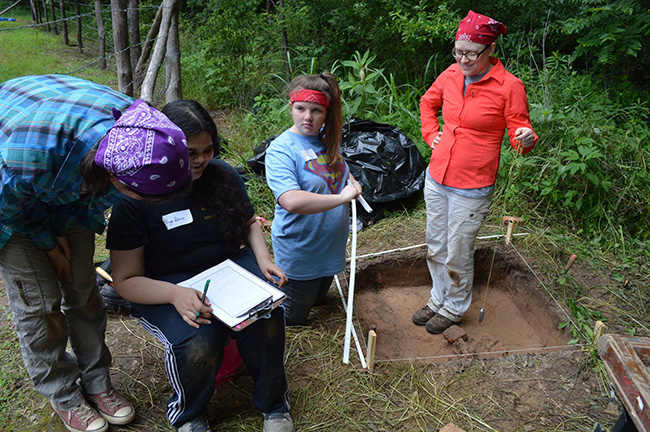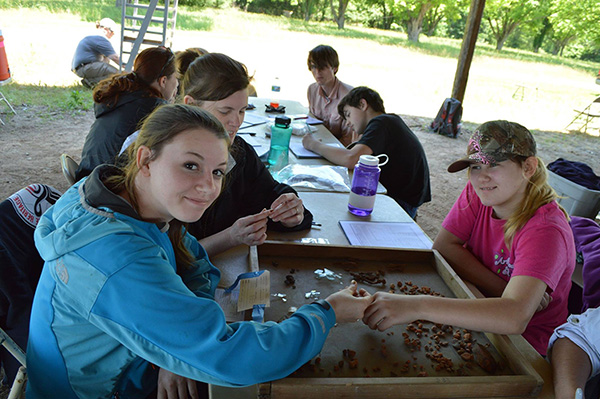
Jodi A. Barnes and Hope Bragg
It is spring break, the daffodils are blooming, and 65 4-H youth are playing drop the handkerchief and learning about the Native, African, and European American peoples who had lived in this area. They learned to use the atlatl as well as why archeologists screen for artifacts.
An important part of the Arkansas Archeological Survey’s (ARAS) mission is to communicate what we learn about the past with the public. One of the ways we meet this goal is to partner with organizations like the University of Arkansas Division of Agriculture’s 4-H or Boy Scouts. For instance, the University of Arkansas at Monticello Research Station has partnered with Desha County 4-H to develop a number of projects to actively involve youth in archeology. The mission of the Division of Agriculture’s 4-H is to provide opportunities for youth to acquire knowledge, develop life skills, form attitudes, and practice behavior that will enable them to become self-directing, productive, and contributing members of society. This overlaps with the mission of the Survey in its dedication to service and education. As a result, the partnership has resulted in two successful programs: 4-H Day of Archeology (formerly 4-H Quad Day) and the From Field to Report program.

The 4-H Day of Archeology began in 2014 during the excavations at Hollywood Plantation. Hope Bragg, a member of the Arkansas Archeological Society (AAS) and the Tunican Chapter of the AAS was recently hired as the extension agent for Desha County 4-H. With her active involvement in the AAS, Bragg saw archeology as a great service learning opportunity for the youth involved in 4-H. As a way to introduce 4-H youth to archeology, Bragg organized an event that brought youth from across southeast Arkansas to the 1840s plantation house being restored by the University of Arkansas at Monticello. Students learned about Native American life, Dutch oven cooking, historic games, and archeology.
This program continued both in 2015 and 2016 (though weather restricted the field component) with growing interest. In 2017, we visited a new location and time period – Rohwer Japanese American internment cemetery and the World War II Japanese American Internment Museum in McGehee. Youth toured the site and the museum doing educational scavenger hunts and learned to map a cemetery. Over 50 people attended. As a result, 89% of participants responded to a survey that they now know why archeology is important. All of the participants indicated that they learned why it is important to learn about other cultures and 90% said they could explain what an archeologist does. The 4-H Day of Archeology continues to spread across the state of Arkansas, with 2017 seeing 32 youth participating in an exploration of Historic Washington with the SAU Research Station and 23 youth learning the importance of archeology at Helena/West Helena with the UAPB Research Station.
With the success of the Day of Archeology, we partnered to develop the ‘From Field to Report’ project at Hollywood. Funded by a Heritage Month grant from the Department of Arkansas Heritage, we developed a pilot public education program that focused on landscape change over time and engaged young people in all aspects of the research process from developing research questions to writing a final report.

Tunican Chapter members of the AAS along with Desha County 4-H and ARAS staff wrote the content for an activity book, with Hollywood Plantation as the case study. The writing process was part of a multi-level citizen archeology project, where community members were involved in writing the activity book, preparing the materials, recruiting workshop participants, and implementing the program. The activity book was designed to guide the students through the research process (Tunican Chapter et al. 2015). Chapter 1 sets the scene. It frames the environmental setting and the history of Native American land use and Hollywood Plantation in a discussion of landscape. The chapter includes map activities for the students to compare maps from different time periods to start to envision landscape change. Chapter 2 offers an overview of archeology and continues the map activities with a specific focus on activity areas around the house. Chapter 3 focuses on archeological research methods from writing field notes to filling out paperwork. It also includes activities that teach sampling strategies and soil analysis. Chapter 4 details lab methods and artifact types and provides activities for dating artifacts and conducting functional analysis. In Chapters 5, interpretation is discussed. This chapter includes activities for comparing artifact frequencies across the site and making sense of the findings. The final activity asks a series of questions that follow the format for writing a final report. ‘Where were you conducting your research? Provide a brief summary of the geographical location and the landscape,’ for example. The book also includes a glossary of terms and information about archeology programs in Arkansas and how readers can get involved. After the workshop, the book was revised with the students’ data. It was printed and distributed to participants, educators, and interested parties around the state (Barnes et al. 2015).

